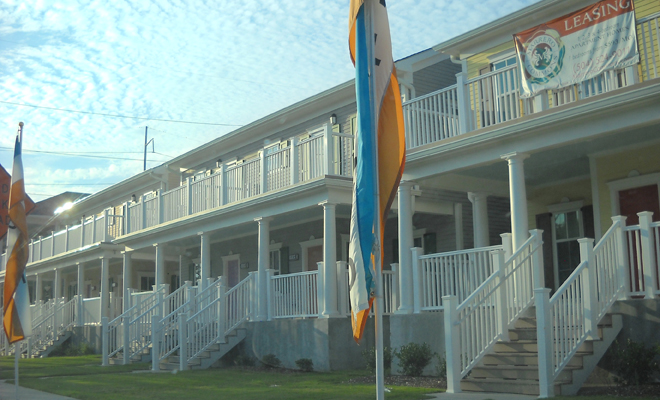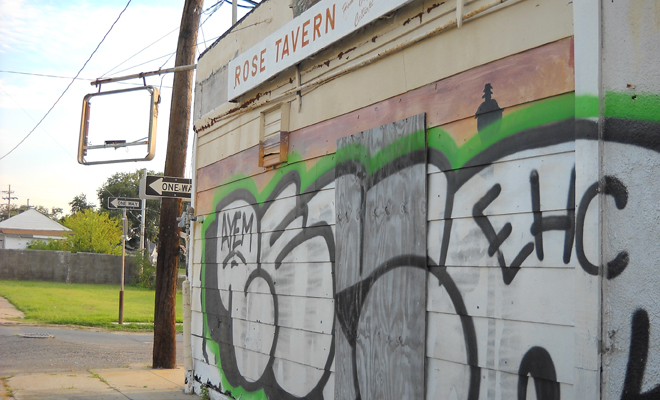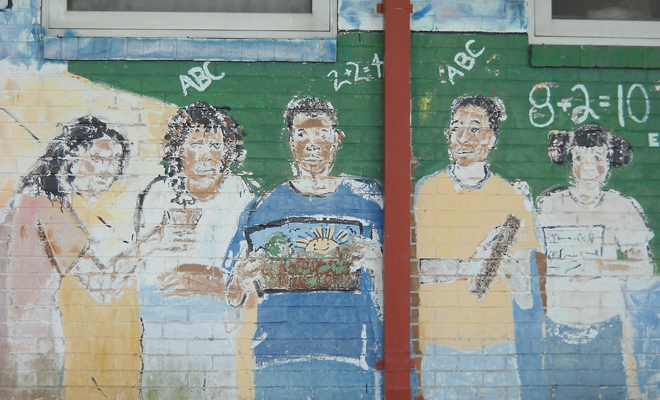The Changing (He)art of New Orleans: Murals & Murders

B.W. Cooper's remaining brick buildings will be torn down during the next year and a half.
Editor's Note
"The Changing (He)art of New Orleans" examines some of the sweeping urban planning projects taking place in the center of the city through the lens of public art—what is being restored, what is vanishing, and what has already disappeared. The first installment in this essay series looks at two murals in and around the B.W. Cooper housing project as it becomes Marrero Commons.
The faded mural depicts three vignettes. In the center, a group of children display school projects in front of a chalkboard with EDUCATION IS THE KEY written on it. To one side, the green of the chalkboard fades into a background of whooshing blues and whites as young men shoot hoops. One lifts a little boy so he can catch an airborne basketball. On the other side, three adults and children of different ages stand on open rolling land, a blue sky and wispy clouds on the horizon.
The mural is painted on the outside wall of an auditorium in the B.W. Cooper housing project, also known as “the Calliope.” South of the auditorium stand the last two-story brick buildings of the original project, built in the 1940s. On summer evenings, families play cards on the porches and children kick soccer balls in the grass of the courtyards before retreating inside at dusk as part of a police-enforced summer curfew to stem the area’s crime. The two-dozen buildings—which house roughly 200 households of the development’s former 1,400—will be torn down during the next year and a half. North of the auditorium, bulldozers are working over fresh soil next to rows of new, pastel-colored townhouses. LIVELOVENOLA proclaim fresh tarp banners, advertising Marrero Commons, the mixed-income development replacing the projects. A month ago, the first group of families from the original housing project moved into the new apartments.
These apartments are the most recently completed part of an experiment occurring citywide, where the city’s old brick housing projects are being replaced with mixed-income units. The closure of the housing projects after Hurricane Katrina is one of several factors blamed for the fact that many impoverished and predominantly black renters did not return to New Orleans. The units in Marrero Commons will be evenly split between market-rate apartments and units set aside for low- and moderate-income residents. Others are receiving vouchers. On an April afternoon, I tossed a football around with some kids in one of the old B.W. Cooper courtyards, including two brothers, six and nine, who wore matching striped shirts. “Do you live up there?” I asked the younger one. My eyes followed a little girl walking up a dingy corridor to the stairs. “No!” he replied. “We used to. Now we live in a motel. Then we’re going to move into a new house. It’s a clean house.”

Marrero Commons is the mixed-income development that is replacing the projects.
The Cooper homes and Marrero Commons occupy a third of a square mile in an industrial part of Central City, bounded by the thick railway lines above the Superdome and the interchanges of I-10, Business 90, and the elevated portions of Claiborne and Broad Avenues. The great question that hangs over Marrero Commons is whether the redevelopment will be able to preserve the tight-knit community B.W. Cooper is known for while diminishing the violent crime that has long haunted the area.
B.W. Cooper’s office is staffed by women who have known one another their whole lives. When I recently paid a visit, a subdued feeling pervaded the building’s dim florescence. Everyone, it turned out, had come from a funeral on Lasalle Street for Briana Allen, the five-year-old shot at a birthday party in Central City. Pink and white programs lay on every desk. The mayor and police chief had appeared at the funeral. The mayor spoke about how New Orleans’ murders have to stop, just as he did six months ago at the funeral of Keira Holmes, the toddler shot in a hail of afternoon gunfire in B.W. Cooper’s Erato Street courtyard.
I spoke with Janet Allen, the coordinator for the project’s summer job program for teens and its chaplain. She was born in 1957 and raised in the development. Her great grandmother, a Seventh-day Adventist who baked fresh biscuits every morning, had been one of the original residents. Allen’s mother served on the board in the ’70s. Allen remembers rose bushes in every back courtyard and sleeping outside in the summer with the windows open: “We didn’t have to worry about gunshots.” She left after graduating from Booker T. Washington High School at 17. When she returned in the ’80s, federal housing programs were being defunded and things were starting to change.

The mural on the now-defunct Rose Tavern has been covered by graffiti tags.
As urban crime rates spiked nationwide, the blocks of the Cooper housing projects became notorious as a locus of street gangs and the various federal, state, and local agencies involved in the war on drugs, an image popularized by Master P’s No Limit record label. In the decade before Hurricane Katrina, there were 88 murders in the projects alone, not counting anyone killed by police. The Rose Tavern on Dorgenois Street used to be decorated with graffiti angels' wings and a rainbow mural memorializing Randall Watts or “Calliope Slim,” an alleged contract killer for a drug gang who was murdered in 1997. The raucous second line at his funeral culminated in his casket being brought into the tavern, which faces the courtyard where he was gunned down. A few years later, as part of a campaign to deglamorize street life, the US Attorney and the Orleans Parish Criminal Sheriffs’ offices supervised prisoners who painted the Rose Tavern with a sedate new mural, showing the silhouettes of traditional jazz musicians playing a second line at sunset.
The bar has been shuttered post-Katrina and is now covered by several layers of anodyne graffiti tags. Across the street stand the glinting fences which encircle Marrero Commons, one of the uneasy juxtapositions that mark the neighborhood. Marrero Commons’ market-rate units start at $750 a month and are being touted as “livable, lovable.”
The development was named for the late Yvonne Marrero, a resident leader. While other housing projects controversially never reopened in the wake of Hurricane Katrina, she and other community members fought to keep some buildings for residents while the new construction was completed. Thanks to their efforts, the old brick buildings on Earhart are still occupied. But the name Marrero carries connotations of pain in what remains a troubled area: in 2002, her son Ernest Marrero was shot in his car on Rocheblave Street. The 27-year-old had been incarcerated for drug charges at 16 but stayed away from that world upon his release in 2001. He was spending time with his family, volunteering, and starting a janitorial business. His clean-cut nature may have raised suspicions that he was a snitch. “What haunts me is that nobody can answer why,” Yvonne Marrero told Michael Perlstein in a 2004 Times-Picayune series about how New Orleans became the nation’s murder capital—a distinction it still holds in 2012. After Ernest was shot, Marrero continued to work doggedly to improve the situation of residents. The apartments her son was shot in front of have been demolished and the new buildings being constructed now bear her name.
“Yvonne Marrero’s dream was to move people into safe housing,” says Donna Johnigan, now president of the resident board. Johnigan, 61, moved into the development in 1971 and is known for her frank criticism of crime and her advocacy on behalf of fellow residents. Over the years, she has been through countless cycles of struggle, resilience, and pain. In June 1995, AmeriCorps volunteers and her daughter Liz, who was working in B.W. Cooper’s youth outreach program, led schoolchildren in painting the mural on the auditorium. The mural’s images—the multigenerational group standing on open land, the children by the chalkboard, and the men playing basketball—seem to represent what social workers wish would save the development’s youth, particularly the men: community, education, and sports. That November, Donna’s son Levi was killed in a shooting, his bullet-ridden body dumped on the emergency room ramp of Charity Hospital.

One of three timeworn scenes painted on the auditorium of the B.W. Cooper housing project in New Orleans.
At a recent town hall meeting inside the auditorium, residents crowd in, sitting on folding chairs and standing around the room’s edges. Darlene Sanville, who works with Marrero Commons, explains that residents will be given priority for the new apartments based on when they moved into B.W. Cooper, the size of the apartment they need, and their income tier. Donna Johnigan takes questions from the crowd. She knows everyone by name. When the subject turns to the area’s increased New Orleans Police Department patrols, Johnigan notes that the recent opening of the brand new units will not instantly make crime disappear.
“Sometimes bullets bounce off of the bricks but they’re not gonna bounce off Marrero Commons,” Johnigan says. “We need to be ready.”
The new wooden townhouses will be less resistant to hurricanes than the bricks, too. As she speaks, I look out the narrow rectangular windows. On one side, I can see an old brick apartment building with a busted screen. On the other, a man in a yellow t-shirt and hard hat walks across an expanse of fresh brown dirt. The Easter-egg shades of the new buildings are just visible on the horizon. The mural’s image of people surrounded by open land is becoming downright eerie. On the other side of the railroad tracks and interstate, Charity Hospital and a score of other buildings have been demolished to make room for a new medical corridor. The main structure of Booker T. Washington High School, which stands at the southern edge of the Cooper homes, will be torn down this summer and replaced by the expanded campus of the financially strapped New Orleans College Prep charter school. Ever-present billboards advertise Marrero Commons with crisp shots of young, interracial professionals. They tower over the bail bond shops on Tulane Avenue.
Thinking about the dilapidated groceries that take food stamps nearby, about the polluted industrial land and machinists—thinking about the police blotter—it is hard to believe that the development’s market-rate units will be rented any time soon. But it is possible to imagine a future where Marrero Commons will be inhabited by young workers from the huge hospitals to be constructed in coming years, where a few members of the old B.W. Cooper families will remain in the development’s low-income units, included as the neighborhood’s services improve. Whether that is realized or desirable—what it will mean for all the families moving into the new buildings and those who have been and are being displaced from the core of New Orleans—won’t be clear until decades after this auditorium and its mural have been torn down.



